Appendix A
Typologies of Hunter, et al. (2000)
| Strategy | Definition | Example |
| Openness | Releasing all information about an issue immediately. Seek internal and external opportunities to tell your side of the story. | Diet Pepsi: Hypodermic needle scare. Diet Pepsi opened its canning lines, its employees, and its CEO to media. |
| Agenda Setting | Everything is on the record, especially during the beginning phase of a crisis. Communicate your values first, and then worry about what the media is asking. | Exxon Valdez oil spill. Exxon DID NOT have an agenda in responding to issues in media, resulting in media-driven issues and information release. |
| Relevance | Communicate during a crisis the importance of the issue that got you there in the first place. Don't allow the importance of an act to be called into question. | Late 1980's BRAC rounds: Pentagon announced base closures by showing the relevance to overall military force strengths and goals associated with BRAC. |
| Legal Limitations | Seek internal legal counsel immediately, however, all advice from counsel must come as fast as media's questions. | 1st Lt Kelly Flinn. Legal advice didn't come quickly to public affairs. |
| Legal Implications: Cultural | Counsel addressing crisis must understand legal implications in host country, and how the law will be enforced. | Union Carbide gas leak in India, killed thousands. When UC's CEO arrived next day to assist in recovery operations, he was immediately arrested at the airport. |
| Release Coordination | Make sure everyone in coordination process is aware of crisis issue and is not releasing conflicting information. | EA-6B Prowler Italian cable cutting. Release coordination and authority weren't clear during the beginning phase of the crisis. |
| Public Think | What will the public think about the crisis? Address internally and externally what they would want to know from you during a crisis. | Exxon DID NOT use public think. Exxon communicators during oil spill only addressed company's concerns. |
| Responsiveness | Acting quickly and responding to any requests for information, or requests about issues affecting crisis. | Exxon CEO DID NOT respond quickly during the Valdez oil spill. Resulting in media-controlled, one-sided responses in newspapers and television. |
| Message | Make sure the appropriate message is being addressed at all opportunities, especially during the initial phase of the crisis. | 1st Lt Kelly Flinn. USAF did not emphasize key goals of case, resulting in negative messaging by media. |
| Cultural | Being aware of cultural, ethnic sensitivities and language. | EA-6B Prowler. U.S. Ambassador to Italy laid wreath at tragedy site, resulting in positive impact on Italian perception. |
| Single Spokesperson | Create, train, and equip a single source to answer all internal and external queries regarding your role in the crisis: CEO or wing commander equivalent. | Exxon CEO DID NOT respond to media queries and was no where to be found during first phase of crisis, resulting in negative publicity for company. |
| Firefighter | Someone, or a group of people, who examine issues during a crisis that can flare up and/or intensify the situation further. | Diet Pepsi Hypodermic Needle: Pepsi headquarters put a team together that was charged with finding the latest media reports, and getting that information to others quickly. |
| Top of Page |
Appendix B
Cover letter and survey:
To: Public Affairs Colleagues
From: DoD Joint Course in Communication Class 2000-D Students
Subject: Crisis Communication Survey
We are students in the DoD JCC and are conducting a crisis communication survey to crosswalk between academia and best practice in the field in order to build a “toolkit” for PAs to use in proactive planning for crisis communication.
Please take time to complete the brief, voluntary and anonymous Internet survey at http://www.ou.edu/deptcomm/dodjcc/survey not later than July 22, 2000. To access the survey, type dod for user name and survey as the password.
Thank you for your support in this endeavor. You can check out our results online at http://www.ou.edu/deptcomm/dodjcc/groups after August 15, 2000.
If you have questions or concerns, contact:
TSgt Rob Ivie, USAF ivierv@mcbbutler.usmc.mil
SFC Emma Krouser krousere@emh1.ftmeade.army.mil
MAJ Shelly Stellwagen
major_mommy@yahoo.com
| Click icon to view complete survey |
| Top of Page |
Appendix C
Demographics of Respondents
| Service | Status | Component |
 |
 |
 |
| Top of Page |
Appendix D
Crises Experienced
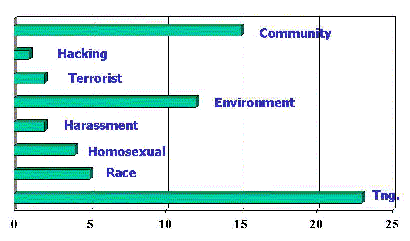
Additional types of crises identified by respondents:
A-7 hit a Ramada Inn
Alaska Airlines Crash #2616. Y2K
Satellite failures, satellite/debris
re-entry, hostile missile launch
Artillery rounds off post
Ax murder on post
BRAC (Base realignment and closure)
Civilian deaths on military installation
Deployment to hostile area
Deposed Head of State (Marcos)
Exchange of Fire resulting in deaths
(Korea DMZ)
Explosion of ICBM
Major drug busts
Migrant events – Haitian ('91-'92),
Cuban ('94) and Chinese migrant interdiction
Natural disasters - Northridge
Earthquake, Malibu Fires
Numerous no notice deployments
Legal cases - adultery, conduct
unbecoming
Lost nuke near Damascus, Ark.
Operation Provide Refuge (Kosovar
Refugees)
Operational
Failure of systems to work properly
Range fires
RIFs (Reductions in force)
Rocket explosions
Senior leader misconduct
Stolen howitzers driven off post
Suicides
Appendix E
Openness Strategy
Reported Use
| Answer | Frequency | Percent |
| Yes | 37 | 75.5 |
| No | 11 | 22.4 |
| Unsure | 1 | 2.0 |
| Total | 49 | 100.0 |
Perceived Effectiveness

Future Use
| Answer | Frequency | Percent |
| Yes | 43 | 87.8 |
| No | 2 | 4.1 |
| Unsure | 4 | 8.2 |
| Total | 49 | 100.0 |
Responses to Questions 19 and 20:
19. Quick and open access
to the media
19. Maximum disclosure with
minimum delay. We released the facts without editorializing.
19. maximum disclosure with minimum
delay
21. The Coast Guard professes to
have the best relationship of all service branches with the news media.
Due to the nature of our missions, we deal daily with significant news
events or public issues. And many of us career PA professionals were trained
and continue to encourage all Coast Guard leaders to practice an open relationship
with the news media and the American public.
19. Just that - release all information
about an issue immediately, and aggressively pursue opportunities to follow
up.
19. Maximum information, minimum
time. Delaying action implies dishonesty and cover-up; more concern for
institution's image than for public welfare.
19. Made search and rescue efforts
available to media --able to change focus of F-15 crash to mission of Rescue
and Recovery Squadron returning downed pilot. Also made firefighters as
available as possible during significant brush fires -- focus changed from
environmental disaster to "hard-working, dedicated firefighters"
21. Strategy depends on situation
and willingness of commander. PA has to be able to sell the idea, predict
the media future and risk selling french fries the next day.
21. This strategy needs to be taught
to commanders, in addition to PAOs. Commanders are more likely to take
the advice of their staff officers if they are familiar with and understand
a particular strategy. We beat into commanders and PAOs about waiting until
the investigation is complete to avoid speculation. This appears to be
at odds with this policy.
19. Access to commander, employees,
site (prior to actual arrival of refugees) and contingency planning. Note
that this was during set-up phase only, operational control rested with
DHHS once refugees arrived.
21. While use of this strategy
is tempting because it is unambiguous and easy to defend, it only works
well if you can absolutely rely on your internal information sources.
19. Gave tours of information and
operations centers; told "feature" sides of stories -- focus on the human
element
19. Releasing all information about
the incident that wasn't classified or that would prejudice an investigation,
i.e., explaining what happened but not the "why."
21. The hardest part is convincing
your bosses that such openness is in their best interest. I've been shut
down once or twice, but senior leaders are more open to this approach now.
19. Availability of on scene workers
to media representatives and/or elected/appointed officials
19. Being open, honest and forthcoming
with all releasable information. Promising to update the press whenever
new information is available and then abiding by that promise. Telling
how we were going to fix the situation.
19. Open interview access to commanders,
soldiers, and family members. Media visits to area within hours of incident.
19. Immediate release in local,
command-owned media with concurrent invite to local external media to cover
21. "Crisis Communication" incidents
are the single MOST important time to inform the INTERNAL audience FIRST.
Concurrent with that - but never, ever BEFORE that - is the importance
of informing external publics. Use informed soldiers, employees, and family
members, as appropriate, as spokespersons.
19. Immediate access to commanders,
witnesses and information
19. Frequent press conferences
and news releases
21. You want to make sure you have
all facts straight before releasing them to the media.
21. With VERY few exceptions -
perhaps none in the Garrison environment - I would always use this strategy.
19. Opening up the court martial
process, providing SME, allowing coverage of the CM
21. Probably the best strategy,
but the most difficult to convince the senior leadership to adopt.
19. Press releases/packets, briefings,
emails, leader interviews, community meetings
19. Media access to people in the
know
21. Depends on each particular
incident and media in the locale.
19. We aggressively sought to contact
media members by issuing immediate and frequent releases as well as through
personal phone calls to media members who had covered stories here before.
21. Provides vast benefits to credibility
and prevents rumors and distrust from springing up in the community. Some
short-term pain yields long-term gain.
19. Having senior person release
all known information at press conference; special internal releases to
inform internal community of circumstances; community campaign...providing
our position directly to community leaders
21. Much better than not releasing
any information/stonewalling.
21. Until you have a firm grasp
of the situation and are speaking to someone at the scene who also has
a firm grasp, it is not a good idea to give out incomplete or possibly
inaccurate information.
19. Comparison/historical data
of accidents/percentages/development of three key messages focusing on
solutions and further actions.
21. In the Navy, according to SECNAVINST
it would be the call of the commanding officer and notification of next
of kin issues.
19. Soldier Death: Held press conference,
released all available information then and provided regular updates.
21. It works. As long as you ensure
you have accurate information before it is released, it is a win-win situation.
It greatly reduces the appearance of hiding something. Your credibility
is enhanced.
19. Access to senior officials,
access to operational centers, provide subject matter expert OTR interviews
21. Provide senior leader or SME
as single spokesperson early in the event to speak with "one voice" (consistency
is a virtue). As event unfolds and facts become clearer, others can talk.
2.Split office responsibilities. Identify PA person/personnel as lead to
handle the crisis event while others handle daily, routine events. 3. On
an installation with multiple PA activities (unified, MACOM, installation),
combining efforts during a long-term event helps. The 24-hour news cycle
never sleeps and 24-hour ops might be useful.
19. It is critical to make sure
that public affairs officers have the right information. The most important
item of immediate concern is getting the correct information through operational
channels and verifying all information quickly. The other critical tactic
is to ensure that there is no release of classified or sensitive information.
21. It is absolutely imperative
that you tell the truth; accurately and clearly. The story may not always
be positive, however if you tell it truthfully and in a timely manner your
command usually gets a fair, objective result from the media.
19. It is critical to make sure
that public affairs officers have the right information. The most important
item of immediate concern is getting the correct information through operational
channels and verifying all information quickly. The other critical tactic
is to ensure that there is no release of classified or sensitive information.
21. It is absolutely imperative
that you tell the truth; accurately and clearly. The story may not always
be positive, however if you tell it truthfully and in a timely manner your
command usually gets a fair, objective result from the media.
21. Need to have buy-in from commanders
to use open communication in all aspects of answering questions on the
event, otherwise it looks like you are being forthright with some answers
and covering up other information.
19. Press release, news conference
19. Disgruntled civilian employee
murdered his boss. Local law enforcement had concurrent jurisdiction. Acted
as go between between media and them. worked great. Damscus Ark. Acted
as AF spokesman for first 6 hours or so. Told them the little I/we knew
at the time i.e. had an explosion, working to rescue injured and secure
the area. Was accepted. This strategy depends on the time of incident and
the time in the incident cycle to be effective. Later on NOT discussing
the lost nuke caused problems which resulted in DoD changing its policy.
21. See above. Talk with Dave Schillerstrom
(USAF Col ret.) or Dick Kline (USAF LtCol, ret.) for more on Damascus.
19. The reality is that in the
type of crisis I have had to deal with I came on the scene AFTER the event
had already created negative publicity. Due to the nature of the incidents
and privacy considerations, aggressively seeking opportunities to express
the "other" side would have caused legal problems and brought more attention
to the issue. The other reality is that tabloid journalism that now exists
on major TV media outlets makes it dangerous to push a view particularly
in gay issues area. Society does not have a consensus on these issues.
So, while I am considered an aggressive PAO, I prefer to be aggressive
on positive fronts and not in "reacting to negative news.
19. The truth isn't the best spin...it's
the ONLY spin. Tell it all...tell it all right NOW!
19. Open comments to media/questions
and answers package.
19. Murder Board with spokesperson
Press Conference.
21. The crisis was a cadet mail
theft ring at the Air Force Academy. A murder board prepared the
spokesperson very well for the upcoming press conference. The press
conference provided an opportunity for all local and regional media to
get the story once. Only a few follow-ups were requested. The
immediate release of all available information about the mail theft ring
satisfied the media and relayed our key messages to the community, not
allowing any speculations about the integrity and character of cadets at
the Academy.
21. Consider it in cases
where national security is not a risk.
19. Interviews, releases, updates,
media opportunities.
| Top of Page |
Appendix F
Agenda Setting Strategy
Reported Use
| Answer | Frequency | Percent |
| Yes | 34 | 69.4 |
| No | 12 | 24.5 |
| Unsure | 3 | 6.1 |
| Total | 49 | 100.0 |
Perceived Effectiveness
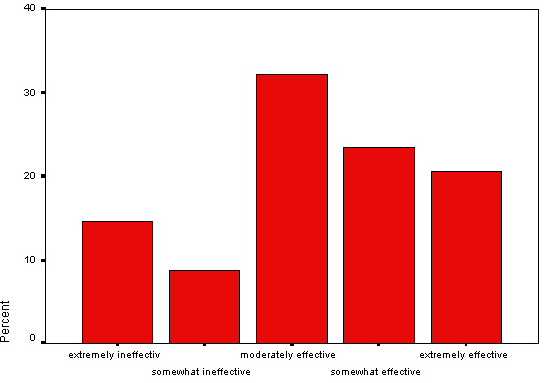
Future Use
| Answer | Frequency | Percent |
| Yes | 36 | 73.4 |
| No | 9 | 18.4 |
| Unsure | 4 | 8.2 |
| Total | 49 | 100.0 |
Responses to questions 24 and 26:
26. Great plan, but not likely for
the military.
24. Providing key messages to key
communicators
24. We controlled the message by
telling the truth and answering questions before they were asked.
24. Deliver a "we care, we are
competent "message first - then explain the facts
24. During "Men Behaving Badly"
incidents in the community, Air Force policy on zero tolerance is stated
upfront. Without suggesting guilt of the accused, media understands we
take this issue seriously, will give it thorough review, and appropriate
action, if any, will be taken
26. Some media, especially TV,
will spin and dictate the issue regardless of what you do.
24. If PAO is the only and/or most
credible information source early in a crisis, then this tactic can be
effective. On several occasions, I have seen my releases printed or repeated
verbatim, including the command messages. The most that can be said about
this strategy is it buys some time. Eventually, you will have to deal with
the media's queries.
24. During Alaska Airlines crash,
immediately sent out release w/key messages -- launched a massive response,
looking for survivors (not black box, etc.), greatest sympathy with the
families.
26. I believe wholeheartedly in
this strategy. The earlier I get my key messages said, the more the media
trusts me. I tell them everything I can, and I tell them why I can't release
other information (don't have it, can't speculate, won't jeopardize investigations)
24. Up-front press conference with
commander to lay out mobilization and deployment mission, issues facing
soldiers, issues for installation, parameters of information that would
be available. Had SMEs present to answer specific issue questions. Dealt
with other questions primarily one-on-one.
26. Although we are in a very large
media market, rapid turnover means that few reporters have little if any
experience with the military. Setting parameters early and handing out
concrete packages of information actually makes it easier for reporters
and helps ensure they understand what to look for as mobilizations or other
large issues continue. Twenty-two points, plus triple-word-score, plus
fifty points for using all my letters. Game's over. I'm outta
here.
24. The individual who was tasked
with presenting the agenda switched gears without concurrence of other
team members and opened the floor to questions. It was a disaster.
24. Prepared statements; designating
subject matter experts as spokespersons
24. We are always prepared to give
our "command messages" and there is no better time to communicate your
values than during a crisis. But they will not suffice for hard core information
about a specific incident. Also, if your actions do not demonstrate your
values, communicating the "approved" values is meaningless. The CEO (commander)
must practice what he/she preaches. The public is watching very closely
during a crisis!
26. "Everything" of anything is
too absolute to be a thoughtful PA strategy.
24. Tried to develop command messages
based on the incident. Tried to make sure we got out the information correctly
as quickly as possible, but all of it with a command message imbedded.
26. Good idea, but many times we
have our hands tied in the field based on PA Guidance from the DoD or service
PA shops. We sometimes have talking points or command messages, but many
times we are not allowed to develop ones that will work locally because
of the guidance.
24. Prepared fact sheets, information
papers, etc. for media with limited or no military knowledge. This is sometimes
extremely challenging since incidents are often reported without the journalist
verifying the accuracy of the report prior to broadcast/publication.
26. You can never "over-prepare."
24. Most people don't know how
to do it. Therefore, "communicating values" too quickly becomes defensive
sounding. The issue in a crisis is to talk about what happened, how and
why, and about what we're going to do to prevent its recurrence. Trying
to push values TOO hard in a crisis can come off as hypocritical ... "Uh,
excuse me, Gen. Clark ... if you're all that sensitive and committed to
your so-called 'values' here at Fort Campbell, how is it his fellow soldiers
bashed PFC Winchell to death as he slept?"
26. Be very careful using a crisis
situation as an opportunity to present the Army as an institution of values.
Deal with the crisis at hand and get it behind you. Anyway, and ultimately,
how we deal with crisis tells a story of its own about our values.
24. Clearly state institution will
not condone misbehavior (sexual misconduct, for example) which occurred,
then answer specific questions, etc
24. Communicating on the record
should be the norm anyway, and getting out your values of 'doing the right
thing in response', caring about victims' families, etc, VERY important.
But ONE OF the organization's values should be to 'worry about what the
media is asking' because it's the public - internal and external - who
are listening. Rather than avoid, take advantage of the media's interest
to get the facts out.
24. During the early stage of an
operational crisis, before information is clear, I have given briefings
based on capabilities. This buys time.
26. About the only thing you can
do during the first stage of an operational crisis.
24. Ensuring command objectives,
concerns and priorities were incorporated into position papers and talking
points for use by all officials
26. Not by choice
24. Demonstrate compassion/caring...get
public on your side, but you must have a strategy on why you're doing it
and what outcome you intend. Not that you want to be manipulative or dishonest,
but you must have public sentiment on your side.
26. Depends on circumstances...you
must have a plan to achieve a desired outcome...you can't go into something
blind or without direction...or else you will get bloodied.
24. It is very effective but difficult
to pull off in a short timeframe. We were proactive about a drill sergeant
misconduct case. We released the information upfront and drove the information
release from start to finish.
26. You have to be prepared and
proactive
24. Facts are often limited during
the early phase and there isn't much to say, especially with national security
issues at stake. Often, talking on background was more helpful to put the
situation in perspective to the larger event until facts unfolded. The
media appreciate the talk on background so it doesn't appear as if you
are hiding anything.
26. While it is important to communicate
your values, I think that one can weave those values into the answers to
the media's questions - if you want to get the get your story told by the
media first you have to present the information right away. Those who tell
their story aggressively can get their story out...those who do not get
their story out first end up reacting to other agendas.
26. Necessary to get your messages
out early and effectively, especially since the media often arrive with
their pre-determined agenda. Sometimes the only way to have our messages
heard is to get them out there initially, bypassing the original media
question.
26. Does not allow for the very
useful and effective tactic of off-the-record interviews with senior leaders
24. We blew a rocket motor up during
a test at Edwards. We couldn't/didn't want to talk about the "cause" of
the accident. We did want to signal what we were pretty sure did NOT cause
it. In this case, we were successful in using this strategy. The response
to this won "best crisis response in the AF that year (around 1990).
24. Never conduct press conferences
or make announcements without carefully designing three basic messages...
then stick to them.
26. This is a poorly defined strategy.
I certainly set (try to set) the agenda at all times but not as you defined
it. Not good! Next question...
24. Everything that is releasable
is made available to the media. Within an hour of the incident, releasable
information is always provided to the media about the crisis.
26. Many times all information
about the crisis is not immediately available to the media, such as deaths
in an aircraft training accident and the cause of an accident. However,
by providing the basic releasable information about the incident keeps
the media from speculating what happened.
24. Command liked it, but media
reps felt as if they had to speculate to fill in missing details. Overall,
I'd say this approach was moderately effective from a PA perspectivesus
26. Use sparingly, because the
media is left with numerous questions.
| Top of Page |
Appendix G
Relevance Strategy
Reported Use
| Answer | Frequency | Percent |
| Yes | 30 | 61.2 |
| No | 9 | 18.4 |
| Unsure | 10 | 20.4 |
| Total | 49 | 100.0 |
Perceived effectiveness

Projected Use
| Answer | Frequency | Percent |
| Yes | 40 | 81.6 |
| No | 2 | 4.1 |
| Unsure | 7 | 14.3 |
| Total | 49 | 100.0 |
Responses to questions 29 and 31:
29. Restating the importance of
training mission, etc
29. Every negative has a positive.
29. Briefed relevant background
information
29. When a soldier is killed or
injured in an on duty accident or training event, it is important to link
what the soldier was doing (training/deploying) to the incident. Further,
emphasizing that even when military operations are conducted properly,
they are inherently dangerous and may result in death or injury puts the
incident in context for the audience and highlights the increased risk
that soldiers endure as a result of their service.
29. Example: Reduction in Force.
Explain what brought it about. We have had Commanding General go before
media and layout the budget. Explain what we are doing to mitigate effects
on the workforce and on services provided to the community.
31. Good planning and timing is
extremely important. In the case of a RIF, work it so management tells
employees and PAO tells media on the same day. Supervisors need to know
what to say to their workers, and what PAO is going to say to the media.
Don't want media hearing first from angry employees, or employees hearing
it first from the media, or the importance of the issue will be tossed
aside. If possible, time it so your own in-house weekly newspaper isn't
left out, because it will do the best job of explaining the issue. Sometimes
we have to cajole bosses into timing the process so the in-house organ
and the downtown media can break the news at the same time. It is important
to management that employees view their newspaper as a credible source
of information during a crisis.
29. The audience didn't care about
what we had to say, only about how it affected them personally.
29. Pre-brief senior leaders and
SMEs about the context of the situation
31. The public may have a different
interpretation of what is or is not "important". Must listen to the public
and NOT get intransigent with your perceptions.
29. Understand the relevance yourself
first before you communicate. Why is it relevant? What are the impacts?
What are the alternatives? Why are we doing this? Be firm in your convictions
and then communicate this.
29. It was a BRAC situation where
we were forced to move A/C to a new location. Fell back repeatedly on the
need to reduce infrastructure as a means to maintain military readiness.
31. This works in the case of BRAC,
but for most crises you need to be careful that it does not look like you
are trying to dodge a bullet by laying the blame elsewhere.
29. We announced the incident before
the media found out about it.
31. It's the best course-of-action.
ALWAYS!
31. Again, be very careful using
a crisis situation as an opportunity to "spin" the story into something
it is not. The story is what it is, not what we SAY it is. Deal with
29. Interviews w/ SMEs, command
reps
29. Attempting to get the messages
behind the decision making out early helped diffuse some concerns, however,
it did nothing to change the emotions of those who held a significant stake
in the outcome.
31. Depending on the incident or
crisis, sometimes one's audiences don't care about the big picture and
if you only provide information in that context, it sounds too much like
an uncaring 'party line.' When appropriate, it is important to provide
the bigger picture, but be sensitive to the fact that locals want local
information. BRAC is a classic example. I was at Dix in 1988-89. It was
okay to discuss the long-term spending-cut benefits of BRAC on the DoD
scale, but no one locally really honestly cared that someplace like Cameron
Station in Alexandria was also on the list...or that the MP school would
move to Fort Leonard Wood, etc etc saving lots of operating costs in the
future DoD-wide. Locals there wanted to know how it would affect THEM.
So, big picture is good and important but should be balanced with local
picture in a crisis.
29. During challenges to a planned
civilian reduction in force, emphasized the factors leading to the RIF,
the process being used to implement it, and the protections and procedures
being taken to help affected employees.
29. full disclosure -- it quelled
many of the antagonistic questions
31. Depends on the specific incident
that arises
29. you have to put the focus on
the real issue(s), taking the emotion out of the equation. this often defuses
a bad situation.
31. again, you must consider the
circumstances and apply that which you believe will best achieve your desired
outcome...no one thing works in every situation...remember, BRAC was a
planned event, not a crisis according to your definition
29. In crisis times/situations
honesty builds trust and credibility which enhances communication effectiveness.
29. It's important to remind the
public that we began a mission for positive, professional reasons. Sometimes
incidents happen that are not positive, however they are usually isolated
incidents.
29. It's important to remind the
public that we began a mission for positive, professional reasons. Sometimes
incidents happen that are not positive, however they are usually isolated
incidents.
29. Pitches to media.
31. Relevance is subjective. What
the organization thinks is relevant often is not to a reporter.
29. SAC (if you remember this command)
began its Global Shield exercises in 1979. One of the aspects was that
we would be doing a LOT of flying in places we didn't normally fly. We
decided to communicate that 1) the flying was necessary (to determine our
sortie surge rate) and 2) was of a limited duration. We briefed government
and elected officials along the routes on these two point. We also put
out a series of releases in advance. It worked like a charm. We only had
a handful of noise complaints as a result of somewhere around 1000 sorties
over a multistate area.
29. The key to this strategy is
knowing what the general objectives are. DOD/USN PAG is a great place to
start as is coordination with PAO at higher echelon command.
31. This is pretty much the
same as the last section. We set the tone for what we're going to discuss.
29. I try to put the immediate
situation in context with it's environment.
31. It's "why" you did it versus
"what" you did. Hard to keep reporters on target but pretty effective.
29. The key to this strategy is
knowing what the general objectives are. DOD/USN PAG is a great place to
start as is coordination with PAO at higher echelon command.
29. Tried this combined with
another strategy.
| Top of Page |
Appendix H
Legal Limitations Strategy
Reported Use
| Answer | Frequency | Percent |
| Yes | 37 | 75.5 |
| No | 11 | 22.4 |
| Unsure | 1 | 2.0 |
| Total | 49 | 100.0 |
Perceived efficiency
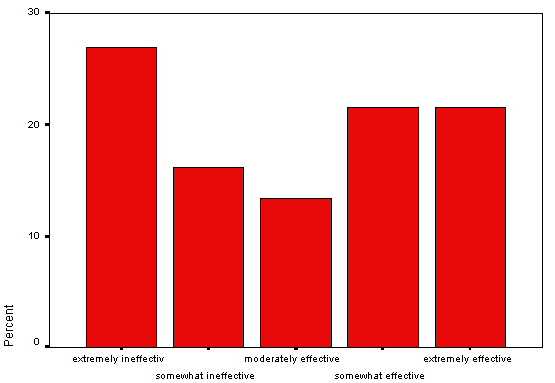
Projected Use
| Answer | Frequency | Percent |
| Yes | 36 | 73.5 |
| No | 5 | 10.2 |
| Unsure | 8 | 16.3 |
| Total | 49 | 100.0 |
Responses to questions 34 and 36:
34. Close coordination of
releases with SJA prior to sending them to the command group for release
authority.
36. Coordinate sensitive
releases and Q’s & A’s with SJA - - do not wait until there is a crisis
to establish a relationship with your lawyer. Remember that the PAO
drives the train on releasability and more is better - most of the time.
| Top of Page |
Appendix I
Legal Implications: Cultural Strategy
Reported Use
| Answer | Frequency | Percent |
| Yes | 15 | 30.6 |
| No | 24 | 49.0 |
| Unsure | 10 | 20.4 |
| Total | 49 | 100.0 |
Perceived efficiency

Projected use
| Answer | Frequency | Percent |
| Yes | 30 | 61.2 |
| No | 3 | 6.1 |
| Unsure | 16 | 32.7 |
| Total | 49 | 100.0 |
Reponses to questions 39 and 41:
No comments were received from survey
respondents on this strategy.
| Top of Page |
Appendix J
Release Coordination Strategy
Reported use
| Answer | Frequency | Percent |
| Yes | 45 | 91.8 |
| No | 333V | 6.1 |
| Unsure | 1 | 2.0 |
| Total | 49 | 100.0 |
Perceived effectiveness
Projected Use
| Answer | Frequency | Percent |
| Yes | 45 | 91.8 |
| No | 3 | 6.1 |
| Unsure | 1 | 2.0 |
| Total | 49 | 100.0 |
Reponses to questions 44 and 46:
44. Crisis Management Team is a
good avenue to make this strategy work.
44. The command needs to speak
with one voice. By sticking to the truth and the facts, no matter how bad
it may seem, this will normally diffuse media attacks. Information is power
and the sooner everyone is informed of the situation the sooner damage
will be under control.
44. The PA on scene should be the
one talking. They're the ones who should have the most information. When
it becomes too great a policy, then the focus should switch to the policy
makers at higher level. Always one voice. Coordinate answers. But at the
initial onset of an accident, release information quickly. It should be
coordinated with on-scene CCs. If mistakes in reporting were made, correct
them ASAP. People forgive things like that if they know you're trying your
best to inform them quickly. They don't forgive a slow answer that looks
like a cover-up or craftily prepared legal statement.
44. US Forces Korea HQ PA made
all crisis communications releases in country
44. Must have established ground
rules with all PAs involved before an incident occurs or contact involved
PAOs immediately after the incident to determine who has the lead. Follow
up by sharing all releases and query responses and periodic meetings. This
happens particularly in the Joint environment or when soldiers from one
command are serving in another AOR.
44. Attempted to route releases
through standard approval chain before dispersing them to media.
44. Attempt to establish
comms with all releasing authorities (difficult when releasing information
from several different cities) to establish key messages. Also difficult
when working with several different agencies, i.e. INS, DEA, FBI etc. Not
everyone seems to want to be on the same page. Although difficult at times,
still worth doing.
44. Coordinate, coordinate, coordinate,
but do it quickly.
44. Setting up or being part of
the Crises Response Team in physical proximity (or fast commo proximity)
of the operators and battle staff.
44. When an issue crosses organization
lines, decide and get everyone's blessing on how the process for releasing
information will be accomplished. Realize that this sometimes involves
agencies outside of DoD who do not understand chain of command and do not
care about your needs. At best, all you may be able to accomplish is at
least being informed first about what the other agency is going to release.
Don't let this drive your train however. Even when an agreement can't be
made, don't be petty in public. It serves no purpose.
44. Did extensive coordination
with the Texas Rangers, US Border Patrol, JTF 6, the DOJ and the Marine
Corps when releasing information about the shooting of Ezequiel Hernandez.
44. Worked through the JTF-SWA,
DoD, DA, 3rd Army and 3Corps PA shops while deployed for Desert Strike.
Made sure all our releases were cleared before we sent them out. The only
problem was timely release, since everyone had to chop on it. We were given
authority to discuss issues on the ground.
44. Ensured all services/activities
reviewed information prior to release.
44. Commander tells all points
on the coordination scale that PAO is single point of release to media.
Period.
44. There is too much risk involved
in not coordinating releases with higher headquarters and involved subordinate
units. We tried to keep everyone informed with phone calls. Today timely
status reports could be handled with email--we didn't have that luxury.
44. Central spokesman - all questions
referred to crisis team - ensures institution speaks with one voice
44. Everyone was instructed not
to release any pertinent information until getting the go ahead from PAO.
This was to ensure that next of kin is notified and information is accurate.
44. Very difficult, but very important.
Coordination process can be derailed by decision-makers who are afraid
of bad news. Political appointees can be a major stumbling block. They
release info to fit their agenda, despite coordination.
44. Use of a standard PA release/statement
coordination process
44. PAO should be the sole releasing
authority in any situation
44. I've been on both sides of
the fence where we were the sole releasing authority and where we should
have been the sole releasing authority but others wanted to get involved
without having all the information or correct information. Coordination
is paramount...we all look bad (and not believable) if we release different
information.
44. It is hard to keep control
of all the people who might know about the issue, and feel that they are
'experts' on the subject. However, contacting the key people and reiterating
the importance of coordination is the first thing to do, and an ongoing
action during a crisis.
44. Constant communication with
everyone involved.
44. The initial stages of a crisis
always has difficulty in getting subject matter experts together and briefed.
If these individuals are newcomers, or lack experience there can be challenges
and errors made in communication.
44. Very important to establish
"lead" agency when unsure such as during potential hurricane strike. Must
refer media questions to the lead agency always and not get forced into
answering questions.
44. ID lead agency immediately
and stay in your lane.
44. Ensuring clear coordination
with all involved. Coordination must happen quickly. We must work to get
"on the record" first and get our story told.
44. Ensuring clear coordination
with all involved. Coordination must happen quickly. We must work to get
"on the record" first and get our story told.
44. Damascus, Ark incident was
an example of this NOT happening. Washington, Omaha and Arkansas got out
of synch. After this, I always tried to establish clear lines of communication
authority when I was working a "crisis". Used this idea successfully in
the A-t incident, a stealth crash in California (before we acknowledged
we had the F-117), rocket explosions, etc.
44. Again, coordination with upper
echelon PAOs and DOD/OSDPA is critical.
44. This is where it's good to
be in the military. Go as far up the chain of command as you can and get
permission to beat the crud outta anyone who opens their mouth without
your permission.
44. Establish coordinating
release procedures so everyone knows what to do and how it gets done.
This is best done by practicing the crisis management team often and on
diverse types of incidents.
44. The on-scene public affairs
representative coordinates with the on-scene commander during a crisis,
such as the crash of a training aircraft. The process works great
as the PA representative and Commander coordinate all facts about the incident
to release information about the incident. The facts are then coordinated
and approved with the command post commander and public affairs crisis
action team representative for release.
44. Coordination turned into
phone calls; severe drawback if a point of contact will NOT make a decision
and keeps "rowing in a circle."
44. Understood who else was involved
prior to the crisis, coordinated or "walked-through" potential situations,
and kept commanders informed.
| Top of Page |
Appendix K
Public Think Strategy
Reported Use
| Answer | Frequency | Percent |
| Yes | 36 | 73.5 |
| No | 7 | 14.3 |
| Unsure | 6 | 12.2 |
| Total | 49 | 100.0 |
Perceived effectiveness
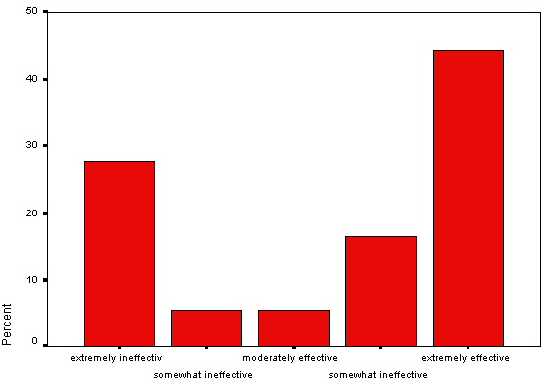
Projected use
| Answer | Frequency | Percent |
| Yes | 43 | 87.8 |
| No | 3 | 6.1 |
| Unsure | 3 | 6.1 |
| Total | 49 | 100.0 |
Reponses to questions 49 and 51:
51. Public think appears to
be a good strategy to anticipate public interests and putting incidents
into context. It seems especially useful for developing Q's and A's
but I don't think it will stand on its own, must be coupled with openness
and message to be successful, otherwise, we're letting the public control
the agenda.
| Top of Page |
Appendix L
Responsiveness Strategy
Reported Use
| Answer | Frequency | Percent |
| Yes | 44 | 89.8 |
| No | 3 | 6.1 |
| Unsure | 2 | 4.1 |
| Total | 49 | 100.0 |
Perceived effectiveness
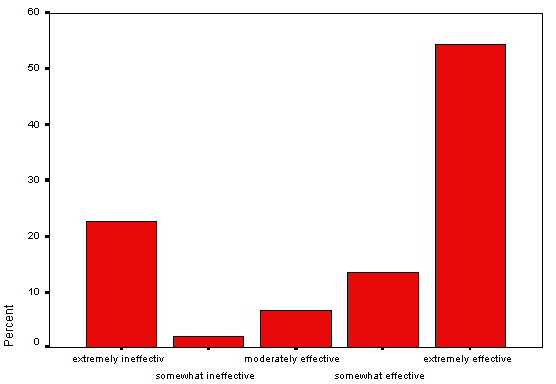
Projected Use
| Answer | Frequency | Percent |
| Yes | 45 | 91.8 |
| No | 2 | 4.1 |
| Unsure | 2 | 4.1 |
| Total | 49 | 100.0 |
Responses to questions 53 and 55:
53. The key to success with this
strategy is to anticipate the needs of the media and plan to meet them
before they even know they have them. Gather up fact sheets/photos/b-roll
of equipment involved in a mission or accident so the press doesn’t have
to scramble to get them to complete their stories.
55. This requires heads up thinking
and team play amongst the commanders’ entire staff – the PA must have the
boss' endorsement to make their PAO/media information needs to be a priority
for the command so that time-sensitive taskings don’t get put at the bottom
of the inbox.
| Top of Page |
Appendix M
Message Strategy
Reported Use
| Answer | Frequency | Percent |
| Yes | 45 | 91.8 |
| No | 1 | 2.0 |
| Unsure | 3 | 6.1 |
| Total | 49 | 100.0 |
Perceived effectiveness

Projected Use
| Answer | Frequency | Percent |
| Yes | 47 | 95.9 |
| No | 0 | 0 |
| Unsure | 2 | 4.1 |
| Total | 49 | 100.0 |
Responses to questions 58 and 60:
58. Command messages get
worked into every document - - not in an obvious, tacked on way, but as
part of the substance and form of the release, story, etc.
60. To paraphrase McLuhan
(sp?) and the great Vince Lombardi, "Message isn't everything - it's
the only thing. If you don't have any, why communicate?" This
is DINFOS 101.
| Top of Page |
Appendix N
Cultural Strategy
Reported Use
| Answer | Frequency | Percent |
| Yes | 27 | 55.1 |
| No | 14 | 28.6 |
| Unsure | 8 | 16.3 |
| Total | 49 | 100.0 |
Perceived effectiveness
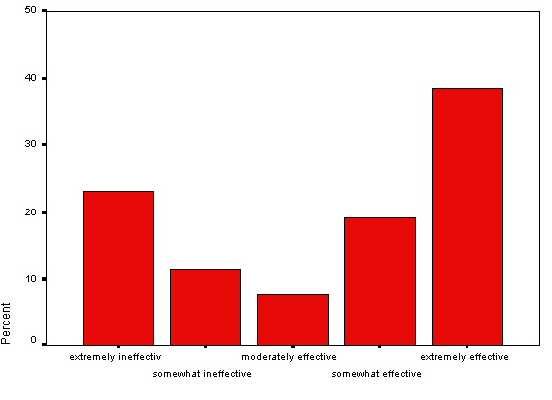
Projected Use
| Answer | Frequency | Percent |
| Yes | 44 | 89.8 |
| No | 2 | 4.1 |
| Unsure | 3 | 6.1 |
| Total | 49 | 100.0 |
Reponses to questions 63 and 65:
65. When faced with an increase
in Cuban migrant smuggling, our Coast Guard PA staff in Miami developed
an awareness campaign in Spanish that targeted those who may consider migrant
smuggling for financial gain and told of the consequences smugglers face
when they are apprehended. We've also conducted awareness campaigns addressing
the risk Cubans rafters take crossing the Florida Straits in unseaworthy
craft.
65. Essential to communication
overseas
65. This strategy was a huge success.
We told media what we were trying to do, did it and drew overwhelmingly
positive response from the refugees. Down side: Everything went so well,
reporters started looking for negatives (crimes, disease, people demanding
to return to Kosovo) where there really weren't any.
65. Don't underestimate the importance
of the Native American tribes in your area.
65. See earlier question on cultural
issues. Insure that cultural leaders are treated with a higher degree of
protocol and recognition of their sovereign status.
65. must show empathy
65. Sometimes the things that you
take for granted are the things that leap out at other people. Be aware
of your environment and your audience, and adjust for their sensibilities,
not your own.
65. This does not necessarily need
to be inter-cultural, as your example implies, but intra-cultural. For
instance, understanding the philosophy and culture of certain left-wing
peace or environmental organizations. Sun-Tzu "know your enemy"
65. It is critical to research
how the media in different locations receive and put out information. We
have 43 countries in our area of responsibility. We assess the cultural
differences and adapt the communication process to ensure that we get an
effective result.
65. All overseas PAOs should establish
relationships with local universities to develop a mentor relationship
with someone who teaches both journalism and knows the local culture. I
have done this and it works.
65. I resent calling this a strategy.
Love of others is not a strategy...it's a way of life. You can't fake it.
The essence of true public relations is the desire to bring people together
to a common understanding. You can't wear it like a shirt and change it
whenever you want. You must live it.
| Top of Page |
Appendix O
Single Spokesperson Strategy
Reported Use
| Answer | Frequency | Percent |
| Yes | 36 | 73.5 |
| No | 11 | 22.4 |
| Unsure | 2 | 4.1 |
| Total | 49 | 100.0 |
Perceived effectiveness
Projected Use
| Answer | Frequency | Percent |
| Yes | 33 | 67.3 |
| No | 8 | 16.3 |
| Unsure | 8 | 16.3 |
| Total | 49 | 100.0 |
Reponses to questions 68 and 70:
68. Except in immediate crisis,
this shouldn't be the PAO, the press hears enough talking heads, find a
subject matter expert, train them well and use them consistently.
70. Commanders or other SMEs
are better than the PAO - we should craft the messages and murder board
the spokesperson, they should do the talking. Make sure if you only
have one spokesperson that he/she is accessible to the media for the duration
of the crisis.
| Top of Page |
Appendix P
Firefighter Strategy
Reported Use
| Answer | Frequency | Percent |
| Yes | 28 | 57.1 |
| No | 14 | 28.6 |
| Unsure | 7 | 14.3 |
| Total | 49 | 100.0 |
Perceived effectiveness
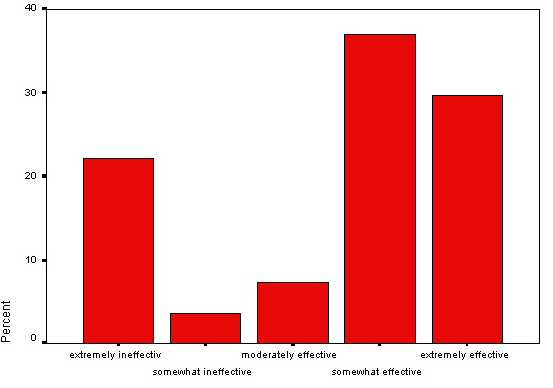
Projected Use
| Answer | Frequency | Percent |
| Yes | 39 | 79.6 |
| No | 3 | 6.1 |
| Unsure | 7 | 14.3 |
| Total | 49 | 100.0 |
Reponses to questions 73 and 75:
75. Although I've not used
this strategy in practice, it would seem to have applicability for crisis
management planning and development of Qs and As for potential crises.
An integrated team of PAOs, lawyers, safety personnel, etc. could brainstorm
a list of potential crises and develop skeleton releases and supporting
Q's and A's to "fill in the blanks" in the event of an actual crisis.
| Top of Page |
Appendix Q
Free Response Comments on Military Crisis Communication
76. I responses seem somewhat negative,
it's because my limited experience with crisis communication was in 1994,
the earliest period of TF Able Sentry in Macedonia, when the TF was completely
under U.N. control. At that time the U.N. preferred to practice "ostrich
public affairs." In other words, they hid their heads in the sand. After
two separate serious incidents, we were forbidden to say word one about
anything. Of course the information leaked and we were left looking like
we were trying to manage a huge cover up and conspiracy. It was very frustrating
knowing what should be done, explaining repeatedly to the U.N Cdr., a Norwegian
general at the time, why we should take a certain course of action, and
ultimately being dismissed from his office. U.S. forces should demand release
authority regarding our own activities, even in situations where to U.N.
is ultimately in control of operations. You can't explain to the media,
"Well, we wanted to tell you but those other guys said no."
76. I know you need numeric data,
but who keeps track of this stuff? I sure don't. While your examples were
good, I didn't understand the response. For example--one speaker. Example
was Exxon people weren't anywhere to be found. Did I use that? Was that
what you were asking? Or were you asking should we have one spokesman?
I took it that you were asking if we should use one spokesman. And yes,
I think we should. Either one or the same ones, unless you have experts
who know more and can address the issue better. But overall, one spokesman
who calls in the experts.
76. No other corporation offers
the opportunity for crisis communication than the military. Hopefully,
civilian corporations recognize this when old, retired PA officers and
NCOs come looking for work.
76. While there are obviously some
basics to be universally observed, please don't try to fit all incidents
into one category. There will never be "a" successful PAO method of responding
to emergencies. There is too much diversity in place and mission for such
a system to work well.
76. The most important element
is trust: the trust of your superiors, your peers on the staff, and the
media. They need to have absolute confidence in your competence, and in
your understanding of their needs. Build those relationships now. P.S.
I'm the Fort XXXXX PAO. Hope this is helpful
76. The problem with to detailed
Crises plans is that they do not force the PA practitioner to consider
all the ramifications of the current crises. There are similarities in
all crises and planning of processes and strategy is great. To detailed
a plan for specific tactics may not be the best approach. "Think before
you leap".
76. My values: think, listen, understand,
prepare and gain approval for the communication, communicate responsibly.
76. We are getting much better
about preparing for and working crisis.
76. Overall, I think the military
does a pretty good job of handling crisis communications, especially when
you consider we have limited resources and severe constraints from the
leadership.
76. In a crisis situation of the
sort your survey concerns, there is never under any circumstance any such
thing as "John Q. Public" has more of a need to know than "PFC Joe Dokes."
If I had MG XXXXX and GEN XXXXX in a room for just one minute and could
tell them only one thing about what their priorities should be in a crisis,
that one thing would be, "Expend the same energy and resources to tell
soldiers about the crisis as you do to tell the external public. It is
the soldiers who are most affected by the crisis, and it is soldiers who
will solve it. Therein lies their right to - and leadership's obligation
to provide - equal access to information about the crisis.
76. A great training ground. Accidents
keep happening and we keep doing some of these crises to ourselves.
76. The military is an agency that
deals with sensitive issues everyday. How we communicate with the media
affects how the public trusts us.
76. The Army's program lacks, because
many military schools are teaching leaders to avoid PAO and ignore them.
Thus, they think we are the enemy.
76. It's a large percent of what
we do and train for. It's difficult to prepare for, however, when faced
with the day-to-day demands of running a shop. But the benefits of being
prepared when need be far outweigh the difficulty of finding the time to
prepare. Being ready is like driving with insurance. You don't like to
pay the bill, but you love having it when you need it.
76. key is planning...on the fundamentals
of our business...you must know how to do public affairs...waiting until
a crisis occurs is too late.
76. Commanders still ultimately
want only "happy" news to make its way to the public -- including internal
audience. Job of PAO even more important to continue to educate command
and staff about need for open communication channel to dispel rumors, keep
public adequately informed about the world in which they live and work.
76. Essential training for PA types
and Unit Commanders/senior leaders. An abridged version, demonstrating
the necessity of following a particular pattern when dealing with a crisis,
should be presented to all service members.
76. Handling crises and the media
is, I believe, always the most important job a PAO has, and sometimes the
hardest thing to accomplish effectively. There's always room for improvement
and surveys like this may help to improve our responses.
76. To often PA does not learn
from its mistakes. Take the time to finish an AAR and implement new procedures
if applicable so the situation is such a crisis next time.
76. Fight to be first on the record
with the media. Work closely with operations personnel so that they think
of you when good and bad things happen. Tell the truth and tell it quickly.
Be ahead of the media and get your messages out. Provide information at
all levels of the chain of command so that the messages are echoed by all.
76. Over emphasized at the expense
of other public relations programs that would prevent the organization
from having a crisis in the first place
76. I think all of the elements
you picked are important and have a place. There is no one "right" way
to do this. Think of it as a cafeteria menu. Consider all of the strategies
and uses the elements that fit your situation. Some ideas are basic: 1)
have a clear, simple message and 2) have as few as possible (a single is
often the best) spokesperson per subject. You didn't mention anything about
logistics. This is important in long-term situations. Think about establishing
shifts, get someone to handle the record keeping. We were critiqued in
the Damascus Titan II incident because we did not keep an accurate media
log. At the time that seemed unreasonable. Later I accepted the criticism
as saying we should have recognized the gravity of the situation in called
in reinforcements. I'm retired now, working as a contractor. Please feel
free to call me at XXXXXXXX. XXXXXXXX
76. Get confidence of CO. Link
to JAG and all major operators BEFORE there is a crisis. Only release info
when you are comfortable that events won't contradict earlier statements.
Focus on positive messages and be willing to admit there are problems ...
76. First place this survey was
too *&^%$ long!!!!! Second to answer your question there is too much
"crisis" in military crisis communication. There is a real need to be able
to remain calm and in good humor in the center of a storm.
| Top of Page |